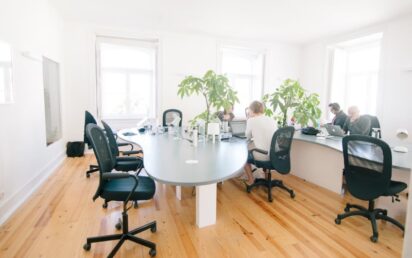A well-structured and productive office environment can significantly impact employees performance, satisfaction, and overall business success. A productive space has much more than functional furniture and the latest technology. It displays features that make it easier for workers to do their jobs.
Letting in natural lighting, uplifting the looks, and investing in technology can help achieve this. Here are five tips for transforming any workplace into a place where productivity and satisfaction meet new highs.
1. Design a Flexible Office Layout
Your office layout needs to balance collaboration with individual focus. Open spaces boost great teamwork and communication, but they can be noisy and distracting. Introduce quiet zones or private pods to care for concentrated workers who need to engage in deep work.
Be flexible and let the team choose the best environment for their task. Consider the multi-use rooms that could be utilised for different needs, from brainstorming to presentations to head-to-head meetings. Designing an office that celebrates diversity in working style builds a dynamic environment where productivity prospers.
2. Bring in Natural Light
Lighting is a powerful productivity tool, and natural lighting is the king for raising the energy bar. Not every office can feature large windows or skylights that fill the space with sunlight. That’s where sun tunnels or sun pipes for pitched roofs can help. These innovative solutions redirect sunlight into interior space to make the dimly lit interiors brighter and more inviting to work in.
Where supplemental artificial lighting is still required, you can employ dimmable LED lights in a natural daylight colour to enhance and support rather than compete with it. Visibility, improved mood and focus, and reduced eye fatigue are all noticeable benefits. Pair good lighting with strategically placed mirrors to maximise light distribution across the office. Consider adjustable lighting systems that allow employees to customise brightness levels for their workstations.
3. Streamline with Technology
Technology is one of the backbones of a modern office; however, too many tools overwhelm your workforce. Choose an integrated, all-in-one communication, project management, and data-sharing system to streamline processes. Regularly evaluate your technology stack to ensure it meets the needs of your team but without added complexity.
Invest in suitable hardware that provides fast Internet, high-resolution monitors, and noise-cancelling headphones to reduce frustration. Have easy-to-use tools to streamline your processes and set up an office where everything will run smoothly.
4. Promote a Culture of Well-Being
There should be a balance in an office setting. Encourage movements throughout the day by using standing desks, holding walking meetings, or even doing yoga breaks. Eating healthy snacks and visiting hydration stations will keep employees’ energy going and sharpen mental clarity.
Everyone’s mental health should be a priority; you need sound mechanisms to ensure this. Have an open culture concerning stress and pressure by recommending counselling or wellness programs. When your team feels their support, they will be more motivated to do a better job.
5. Encourage Personalization and Comfort
Employees would be motivated and interested in work if they feel at home. Allow your team members to personalise their desks with things that make them happy, such as photos, plants, or motivational quotes. Personal touches create ownership and make the office less rigid and invitingly friendly.
Ergonomic furniture should be used to make people physically comfortable. Adjusting chairs, using standing desks, and properly positioning arms on monitors reduce strain and help workers stay comfortable throughout the day.
Endnote
Creating a functional office requires a blend of intentional design and high-tech tools, not to mention an authentic concern for employee well-being. With simple efforts like finding a sun tunnel to allow as much natural light as possible to lighten workflow can make a difference. A comfortable setting will motivate employees to keep performing their duties.


